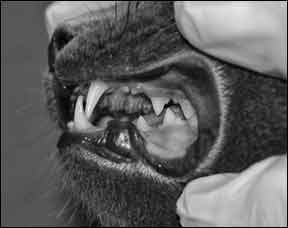If you’ve resisted brushing your cat’s teeth, knowing how strenuously he’s likely to object, consider this: Periodontal disease, an often painful inflammation of the gums that can result in bone loss and destruction of oral tissue, is extremely common. In fact, it’s the most prevalent disease in companion animals and can pose serious health threats.

288
“Periodontitis has been shown to play a role in such health problems as cardiovascular disease and diabetes,” says dental specialist Santiago Peralta, DVM, a Lecturer in Dentistry and Oral Surgery at the Cornell University College of Veterinary Medicine. This disease is, however, entirely preventable, according to the American Veterinary Dental College (AVDC). The best way to prevent periodontitis is by regular brushing and professional dental care.
Loss of Teeth. “If periodontitis, the most serious phase of periodontal disease, is left untreated, it will invariably result in the loss of teeth,” Dr. Peralta says. Severe cases can result in a hole leading from the oral cavity into the nasal passages and/or a weakening of the jaw bone that can lead to fractures. Treatment of more advanced stages may require gum surgery and bone grafts.
The problem begins when plaque, the soft, sticky substance consisting of food debris and bacteria, accumulates under the gum line, or gingiva. The plaque eventually hardens into calculus, known as tartar. When tartar accumulates under the gums, it promotes additional plaque accumulation and disease progression.
Gingivitis, as the initial inflammation of the gums is known, is reversible as long as the plaque is removed and its chronic accumulation is controlled or prevented. “The best way to remove plaque is by mechanical means,” Dr. Peralta says, “and frequent toothbrushing is the gold standard.”
The progression from gingivitis to periodontitis, the stage at which tissue attaching the teeth is destroyed and bone is lost, depends on several factors in addition to the continued presence of plaque. They include diet, genetics and general health:
The role of nutrition. Contrary to the popular belief that wet food contributes to periodontal disease, Dr. Peralta says the most important consideration is the nutritional content of the food. “Cats who receive a well-balanced, good-quality diet are more likely to have competent immune systems and therefore are less likely to develop periodontal disease than animals whose nutritional status is suboptimal.”
Genetic susceptibility. Cats who have been bred to have an altered skull conformation and abnormal bites — for example, the Siamese and Oriental shorthairs — are predisposed to the development of periodontal disease. Bacteria can more easily get trapped between teeth that are crowded, making them more difficult to clean. Owners of these breeds need to be especially vigilant about toothbrushing.
Overall health status. Feline leukemia virus, feline immunodeficiency virus, calcivirus, and other diseases or conditions that suppress the immune system can make a cat more susceptible to periodontitis.
Periodontal disease may start at a young age and go unrecognized for years. Because progression can be slow, many owners recognize its presence only when the cat is older and the disease may no longer be as treatable.

288
Even highly trained professionals may not readily recognize the extent and severity of periodontal disease by doing an oral exam. It can be fully documented only by dental probing and full-mouth X-rays, which require cats to be anesthetized. “Performing a so-called dental cleaning without probing and full-mouth X-rays is many times of little to no benefit for the cat,” Dr. Peralta says.
If no major problems are identified after a tooth-by-tooth examination, the teeth are scaled ultrasonically above and below the gum line and then polished. The purpose of polishing the teeth after scaling them is to remove plaque that may have been left behind. It will also give the teeth a smoother, shinier and whiter appearance. If advanced disease has been identified, periodontal surgery to access the roots of the tooth by cutting the gums or extractions may be necessary.
The Effective Treatment. Dr. Peralta emphasizes that regular veterinary tooth cleaning — the removal of deposits from the surface of the teeth — rather than the administration of antibiotics is the only effective treatment. He particularly discourages the use of “pulse therapy,” the intermittent administration of antibiotics, which is sometimes used with the aim of lowering the bacterial count in the mouth. Following pulse therapy, the problem often remains unresolved, Dr. Peralta notes, and the bacteria become resistant to antibiotics.
Some owners worry about the use of anesthesia, especially with older cats. Dr. Peralta points out that “age is not a disease.” He says, “If a cat is old but otherwise healthy, the anesthetic risk is low.” And, according to the AVDC, “The risk of chronic oral infect is far greater than the risk of an anesthetic complication.”
Up-to-date Monitoring. Your veterinarian will likely perform blood tests and other diagnostic tests before administering anesthesia, and will use up-to-date monitoring equipment during the procedure. Currently used anesthetic protocols are also much less dangerous than those used in the past.
In addition, with the use of local anesthetic blocks, which minimize the depth of general anesthesia required, “Many patients are awake and standing within 15 to 20 minutes of completion of the procedure and go home the same day,” according to the AVDC.
With cats who aren’t in the best of health, Dr. Peralta advises discussing the risk versus benefit of dental treatment with your cat’s veterinarian. “Because advanced periodontal disease can have a huge impact on quality of life and overall health, and can even contribute negatively to other ongoing diseases, most patients will benefit from periodontal treatment, even if they have other serious medical conditions.”
In the end, however, it’s up to you to keep up your end of the dental care bargain. “Periodontal treatments performed by a professional are intended to reverse or halt established disease, but do very little in terms of prevention if an oral home-care regime is not implemented,” Dr. Peralta says.


